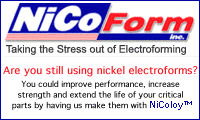
-----
Electroplating for a School Science Project
Q. In regards to zinc plating metal, would it speed up the process if the zinc, vinegar ⇦in bulk on eBay or Amazon [affil link] , salt solution was heated up instead of at room temperature or is the process all in the electrolysis with the anodes?
Jon KirkHobbyist - Indianapolis, Indiana
October 15, 2021
A. Hi Jon. Warming the solution a bit might help to speed up satisfactory plating, but your other phrase about "all in the electrolysis" remains a fact as well :-)
Readers who would like to actually understand how it works should see our "Intro to Faraday's Law" article. But in brief, it is the amperage of electricity applied and only the amperage of electricity applied which oxidizes (dissolves) zinc from the anode and reduces (plates) it onto the cathode -- the temperature has nothing to do with this fundamental electrochemical fact. BUT in the real world, satisfactory plating as opposed to just moving metal from the anode to the cathode, is limited by a number of factors, one of which is the physical migration of zinc ions through the solution from the anode to the cathode, and that reaction is somewhat temperature dependent.
Luck & Regards,

Ted Mooney, P.E. RET
Striving to live Aloha
finishing.com - Pine Beach, New Jersey
Ted can be retained for immediate
answers or long term project help
October 2021
⇩ Related postings, oldest first ⇩
Q. My 5-year-old son wants to do a science fair project on plating. He saw someone on TV plating something and he asked me if I knew how to do it. When I was a kid, a science fair exhibitor plated copper pennies with silver. Do you know someone who can tell me how to do that? It seemed like a simple thing, but I don't know any details.
Darrell Ostler1996
by Steve Spangler
or AbeBooks
or eBay
or Amazon
(affil link)
A. Hi, Darrell. For 5-year-olds, a simple immersion deposit might be more practical than electroplating. Get some copper sulphate
⇦ on
eBay or
Amazon [affil link] . Then get some simple coins or small unpainted parts, clean them with toothpaste and a toothbrush (good to remind the kids anyway), then with vinegar or lemon juice, rinse them well, and put them into the copper sulphate.
Copper will deposit on them. Best of luck.

Ted Mooney, P.E.
Striving to live Aloha
finishing.com - Pine Beach, New Jersey
Ted can be retained for immediate
answers or long term project help
|
S |
1996 Q. Thanks for posting my inquiry and the response. I think I will try the immersion method on a few nickels just to turn some heads. I would still like to do the simple electroplating on copper pennies though. My son gets very excited about electricity and batteries and such. In his mind, if a science experiment doesn't use electricity, it isn't science. Q. My middle-school son wants to do a plating demo as a science fair project. And, yes, I did suggest this based on a demo I saw years ago. what I saw was plating of pennies using a silver spoon as an anode. We were led to believe the bath was simply water, although I now have come to learn that was just a bunch of hooey. 1997 A. Hi again, Darrell. You may find me difficult when, for the second time, I suggest that you do an alternative instead of what you want to do -- sorry :-) A. Hi Dan. Virtually all real silver plating is done out of a cyanide based bath, which is a horrible poison and out of the question for a home or school experiment. With silver nitrate you may form a poor deposit -- sorry, but I really don't know :-( The Electroplating Engineering Handbook ⇦ this on eBay, AbeBooks, or Amazon [affil link] says that to prepare a standard silver nitrate test solution, dissolve approximately 17 g of silver nitrate in a liter of chloride-free water, and store in an amber bottle. While that test solution is not really meant to be used as a plating solution, it sounds like as good a formula as any. But if you prefer, you can buy a pre-formulated silver-nitrate based "resilvering bath" from a number of sources. Silver may not be easily electroplateable from silver nitrate, it may be strictly for immersion plating -- but please let us know what you find. Good luck.  Ted Mooney, P.E. Striving to live Aloha finishing.com - Pine Beach, New Jersey Ted can be retained for immediate answers or long term project help 1997 |
|
C |
1996
|
|
I |
"Earth Science for Every Kid: 101 Easy Experiments That Really Work"
by Janice VanCleave or eBay or Amazon or AbeBooks (affil link)
1998 |
|
I |
Q. I'm doing a science project, for my 4th grade class, on copper plating and I don't quite understand it, could you please help me? New Life Academy 1998 Q. I am a 7th grade student, and I am doing a science fair experiment on copper plating. I am looking at a list of ingredients, and it says to use white vinegar, salt, CuSO4, and deionized water for the plating solution. I was wondering two things: 1. What voltage should I use, and 2. Where can I get CuSo4, or can I use different ingredients? Could you please tell me what would be the best plating solution to copper plate a dime? student - Omaha, Nebraska, USA 2007 1997
I tried your experiment, but my pennies were not very corroded, so I may not have had enough copper in the water to see anything happen on the surface of the nail. 
Tom Pullizzi Falls Township, Pennsylvania |
|
N |
A. Here is what the Rochester branch of the AESF had been using for years as a plating demo at our annual Engineering Fair: bright nickel plating of pennies. Sure, the setup is not as basic as with copper plating, but no cyanide is required and the plate is bright. 
"PlaterB" Berl Stein NiCoForm, Inc. Rochester, New York  1997 ---- |
|
Z |
Q. I am a high school chemistry student who is planning on doing a simple electroplating procedure for the class. I plan on plating zinc onto pennies. This seems to me to be much simpler than using silver. Am I correct in this assumption? Graham W [last name deleted for privacy by Editor]1998 A. I would say yes because I can plate a fairly bright and adherent zinc coating from dilute acetate or sulphate solutions, and I don't know how to do this with silver. 
Tom Pullizzi Falls Township, Pennsylvania 1998 1998 Q. I'm not sure what you mean by references; I have the Metal Finishing Guidebook and Directory. What is another metal that would be good to plate onto copper? Graham W [last name deleted for privacy by Editor]1998 A. That is a very good reference, I did not expect you to say that you have one of those! There are many formulas in that book, but I don't know how many you can use in the home, since it is a reference for industrial users. 
Tom Pullizzi Falls Township, Pennsylvania Q. I'm glad to hear that you think so highly of it. I got it when I interviewed the president of a plating company. I have never even attempted to plate anything yet. I have read the chapter on rinsing, though I admit it got a bit too technical for me, though I'm sure if I had any experience rinsing it would probably make more sense. Graham W [last name deleted for privacy by Editor]1998 ! Idea. Why don't you switch gears, and make your project about... RINSING! The world does not know enough about rinsing. Use your sources from electroplating to expand and expound on the subject of rinsing. Rinsing the soap out of laundry, washing the ice cream out of Breyers' containers. Show your fellow students how much it costs the earth to have clean cars and jeans. Hot water rinses much better than cold water for most projects, talk about the energy cost of rinsing and how it relates to global warming. 
Tom Pullizzi Falls Township, Pennsylvania 1998 |
|
C |
1998 Q. I also have been trying to help my teenager with a science project. Many of the entries here have been helpful, but are scattered. I have some specific questions: A. Yes, Wallace, the thread meanders. That's the nature of public participation, but we do have an
FAQ on "How Electroplating Works" that is arranged in tutorial fashion and will be reasonably easy and straight forward to follow.  Ted Mooney, P.E. Striving to live Aloha finishing.com - Pine Beach, New Jersey Ted can be retained for immediate answers or long term project help 1998 |
Q. I am a high school student currently working on a project that requires me to design an experimental kit for 9-12 year olds, using electroplating techniques to coat personal items with layers of metals. However, I have several queries, they are as followed:
1) how do you plate gold/silver onto non-conductive materials, e.g. bird feathers, leaves, using electrolysis? I am thinking of AgNO3, which will be provided by the school.
2) what are the possible problems that I may encounter, and how would you best recommend I avoid them?
Any help would be very much appreciated. Thank you so much (:
NIL - Singapore
2005
Q. Hello, I am from your school, working on the same project.
Are we allowed to get AgNO3 from school? They said that they're providing us only with Copper(II) Sulphate, which means we can only plate copper, not gold or silver.
- Singapore
2005
Q. Would anyone please help me?
I'm desperately trying to find out how to electroplate a non-conductor, to be exact, a leaf. the leaf needs to be made a conductor so that a coat of metal can be deposited. Does anyone know how to make the leaf a conductor? It needs to be placed in some kind of solution, but what?
I'd like anyone that can help. Thanks
the Hague, Netherlands
1998
A. Hello Susanne (and students from Singapore),
We have an FAQ on how to plate organic materials. Lacquer the leaf so it will not be destroyed by the plating chemicals; spray on a "two-part silvering solution" where one component is a soluble silver compound and the other is a reducing solution, or paint on a conductive paint; then start electroplating.
Now, had you asked me how to create a Renoir impressionistic style oil painting, my advice would have been to dip a brush into paint, spread it on the canvas, and feather it in such a fashion as to give strong realistic romantic forms and surreal lighting -- although I can't sketch a dog well enough that you'd be able to tell whether it was a cow or a horse I was aiming for :-)
The point being that mechanical directions are only 1 percent of the issue; the reason we find artwork beautiful is that we intuitively recognize that it is not a simple matter of cookbook motions; but, rather, a great amount of experience and technique, and sometimes extraordinary talent. Best of luck!
Good luck.

Ted Mooney, P.E.
Striving to live Aloha
finishing.com - Pine Beach, New Jersey
Ted can be retained for immediate
answers or long term project help
1998
Q. I am attempting to immersion plate a copper penny with granular zinc in a solution of boiling sodium hydroxide. I used a 0.1 mol solution. Was this the correct molarity? When I conducted the experiment, one side of the penny became dull grey and the other side didn't plate at all. Do you have any idea why this was?
Graham W [last name deleted for privacy by Editor]1998
A. Graham,
I don't see any such formulas in the handbooks -- where did you get it and why are you doing it? There's a huge difference between electroplating pennies with zinc using safe household chemicals like room temperature vinegar, as Tom described, and trying to use boiling lye!
I hope this is something you are doing under proper lab conditions, with supervision. Boiling sodium hydroxide is really dangerous stuff, even without the zinc dust ⇦ on eBay or Amazon [affil link] . This may not be something you should be doing for/with your high school class.

Ted Mooney, P.E.
Striving to live Aloha
finishing.com - Pine Beach, New Jersey
Ted can be retained for immediate
answers or long term project help
Q. I have already performed the experiment once. It was in one of our high school lab books, but the molarity for the sodium hydroxide was not given. This is my problem. I assure you that I have been performing it under careful supervision. I have been wearing safety equipment, and the sodium hydroxide I'm using isn't strong enough to be a very strong caustic. The zinc is mossy zinc, not zinc dust.
The plate just has not been very satisfactory. It should have turned out silver and was instead a dull grey. I'm perplexed as to why this is, and the only thing I can figure out is that the molarity I used was wrong. Do you have any ideas at all?
A. I don't see the formula, or a similar one, in the guidebooks, so I don't know. There is a 1.1 V electrochemical differential between copper and zinc, working in the opposite direction, so I think the concentration of zinc would have to be high to get zinc to immersion deposit on copper. For scientific background on immersion plating and how molarity effects it, look into the Nernst Equation. Good luck.

Ted Mooney, P.E.
Striving to live Aloha
finishing.com - Pine Beach, New Jersey
Ted can be retained for immediate
answers or long term project help
Q. I was wondering how I can go about Electroplating a diecast car? I've tried to find books on it with no luck. Can you help me? I would like to Electroplate them gold and chrome but need some help. Please let me know if you can help. Thank you.
Jeff Griffith1998
A. Hi Jeff:
There is info on that subject in the books here; I suspect you have been looking in general science project books, etc., rather than in industry books. But the real answer to your question is that you probably should contact plating shops and have the cars plated for you. Working with cyanide-based copper plating solutions, and hexavalent chromium based chrome plating solutions is not a good hobby for most people, and successfully plating old diecastings is difficult even for highly experienced platers :-)
It's one thing to simply demonstrate for students how electroplating works; but it's something very different to obtain quality electroplating on a diecasting. Platers with decades of experience may need a full day to plate a single diecasting from an old car.

Ted Mooney, P.E.
Striving to live Aloha
finishing.com - Pine Beach, New Jersey
Ted can be retained for immediate
answers or long term project help
! ! I know exactly how to plate a copper penny with not only silver but brass!
First you clean the penny really well and don't touch it. Then you take about a gram of zinc shavings and mix that with 20 ml of sodium hydroxide and boil it on low heat. Once it starts to boil, drop in the penny and leave it there for around 10 min. It will turn a silver color. Then carefully take it out when it is totally silver (Still don't touch it) and rinse it off and dry it out for a bit.Then comes the cool part. You pick up the penny with tweezers and gently heat it with a propane torch. Be careful not to heat it too much or it will warp the penny. It about 5 seconds the penny will turn a shiny gold color!
I did this in school today actually, and it worked great! I'm only in 8th grade too, so this would make a good class experiment.
1998
(you are on the 1st page of the thread) Next page >
Q, A, or Comment on THIS thread -or- Start a NEW Thread
